Numerical Calculation and Application for Crushing Rate and Fracture Conductivity of Combined Proppants
Abstract
:1. Introduction
2. Computer Simulation of Micro Arrangement
2.1. Particle Size Distribution
2.2. Physical Modeling and Computer Simulation
- (1)
- Set the ratio according to ceramsite and quartz sand, and randomly appear according to the proportion;
- (2)
- The first row is stacked from left to right;
- (3)
- The second row and above pile up one by one from bottom upwards;
- (4)
- The positioning of each particle is based on the minimum distance from its center to the bottom of the fracture;
- (5)
- When the position with the shortest distance between the particle circle center and the bottom boundary is unique, it is deterministic laying; otherwise, this position is not unique, and it is random laying.
- ①
- The maximum value of the two-dimensional boundary is given, that is, the maximum boundary values corresponding to the x and y axes are wf and Lf, respectively, and the particle size distribution ranges (ceramsite diameter Rc and quartz sand diameter Rs) of the two types of proppant are given. According to the proportion of ceramsite and quartz sand in the proppant ratio and the random number generated, ceramsite and quartz sand appear randomly.
- ②
- In the first line (tangent to the x-axis (0, 0)~(wf, 0)), the first circle center (x1, y1) is (R1/2, R1/2), the first line of circle and circle. The random interval between the amount nx of particles touching with the lower boundary and the random weighted distribution coefficient λi are determined, and the position of the new circle can be determined at the same time.
- ③
- If xi < wf − Ri/2 of the last circle center of the first row (xi, yi) does not hold, then the last circle center of the first row is adjusted to (wf − Ri/2, yi). If xi < wf − Ri/2 holds, the circle in the first row fills the space in the x-axis direction (0, 0)~(wf, 0).
- ④
- In other positions in the two-dimensional space, based on the filled circle centers, determine the set T of the highest (outermost) circle centers in the two-dimensional plane space. By traversing the search algorithm, to find the smallest yi in the new center set, that is, with min(yi) as the criterion, generate a new center (xi, min(yi)).
- ⑤
- By judging whether the new circle intersects, overlaps, or floats with other filled circles, if such a phenomenon exists, go to step ④ and readjust the center of the circle. If there is no such phenomenon, the new center (xi, yi) is determined.
- ⑥
- By judging whether the new center of the circle exceeds the maximum boundary value Lf in the y-axis direction, it is judged that yi > Lf – Ri/2. If it is “No”, it means that the two-dimensional space has not been filled, then go to step ④ and continue to fill new circles. If it is “Yes”, it can be determined that the entire two-dimensional space has been filled, and the loop is exited.
- ⑦
- Select the diameter of the new center again as min(Rc, Rs), continue to appear, and judge whether the new circle (xi, yi) can continue to be filled within the boundary and on the existing circle, that is, when yi < Lf − min(Ri)/2, it is considered that the current two-dimensional space is in a “false” full state (Figure 3a), then jump to step 4, and continue to fill a new circle with a diameter of min(Rc, Rs) in the two-dimensional space. When yi > Lf − min(Ri)/2, it is considered that the current underlying space is “true” full (Figure 3b,c), the loop is exited, and the operation ends.
3. Numerical Calculation of Crushing Rate and Fracture Conductivity
3.1. Mathematical Model and Numerical Solution for Particle Force Analysis
3.2. Calculation of Crushing Rate
3.3. Calculation of Fracture Conductivity
- (1)
- Calculation model of permeability
- (2)
- Calculation model of porosity
- (a)
- The case where none of the composite proppant particles are broken η = 0
- (b)
- The case of combined proppant particle crushing rate η ≠ 0
- (3)
- Calculation model of fracture conductivity
4. Calculation Results and Analysis
4.1. Particle Arrangement and Force Simulation
4.2. Comparison between Calculations and Experiments
4.3. Discussion of Calculation Results
5. Application and Effect Analysis
5.1. Proportional Optimization
5.2. Onsite Construction Technology
- (1)
- As shown in Figure 13, add 40/70 mesh LZ sand (usually 2 m3) to the No. 1 sand box to polish the fracture during the pre-liquid stage. Add 4 m3 of 30/50 mesh XY ceramic particles to the No. 2 sand box. Add 21.8 m3 of 20/40 mesh LZ sand to the No.3 sand box. Add 21.8 m3 of 20/40 mesh XY ceramic particles to the No. 4 sand box.
- (2)
- According to the designed pumping program, first open funnel ① and inject 40/70 mesh LZ sand during the pre-liquid stage. During the carrying-fluid stage, open funnel ② and inject small XY ceramic particles into sand box 2. After all the small diameter XY ceramic particles in box 2 are pumped in, immediately open funnels ③, ④, ⑤, and ⑥, and mix 20/40 mesh LZ sand with 20/40 mesh XY ceramic particles in a 1:1 ratio for pumping construction until the construction is completed.
5.3. Application Effects and Comparison
6. Conclusions
- (1)
- By studying the microscopic arrangement structure of combined proppant particles and based on the randomness and determinacy phenomena in the process of proppant particle arrangement, corresponding solutions were proposed, and computer simulation of combined proppant particles was achieved.
- (2)
- Considering the possible differences in performance, particle size, and proportion of combined proppants, a crushing rate calculation model for combined proppants was established.
- (3)
- A permeability model for composite proppants was established based on the Kozeny–Garman equation. A mathematical model for the crack conductivity of composite proppant particles was established based on the actual situation of fracture width reduction after particle crushing.
- (4)
- The calculation results of the crushing rate of combined proppants with the same particle size and proportion, as well as different particle sizes and proportions, show that under a closing pressure of 10–60 MPa, the crushing rate and fracture conductivity values calculated by the model are in agreement with the experimental values by more than 80%.
- (5)
- The calculation results of combined proppants with the same particle size but different proportions indicate that as the proportion of ceramic increases, the fracture conductivity of the combined proppant becomes greater.
- (6)
- Applied to the fracturing of target block reservoirs with a closed pressure of 45 MPa~55 MPa, the results showed that the combination proppant effectively reduced the proppant cost by about 40.25%, and the oil production achieved the expected results. The daily oil production increased by about 14.10% compared to the production well with all ceramsite. Practice has proven the rationality and effectiveness of combined proppants.
- (1)
- In this research, it is assumed that the proppant particles are in a static laying state. Multiple methods and disciplines such as fluid dynamics theory can be combined to study the key performance parameters of proppant, so as to achieve the purpose of dynamic simulation.
- (2)
- Considering the sphericity of proppant particles and actual reservoir characteristics, additional studies on the embedding and deformation of proppant are important directions.
- (3)
- This article studies the computer simulation of proppants and the calculation of key parameters from a two-dimensional perspective. Carrying out three-dimensional simulation and numerical modeling of proppant particles is an important direction for future work.
Author Contributions
Funding
Data Availability Statement
Conflicts of Interest
References
- Wang, H.Y. Hydraulic fracture propagation in naturally fractured reservoirs, complex fracture or fracture networks. J. Nat. Gas Sci. Eng. 2019, 68, 102911. [Google Scholar] [CrossRef]
- Guo, Z.X.; Chen, Y.Y.; Zhou, X.; Zeng, F.H. Inversing fracture parameters using early-time production data for fractured wells. Inverse Probl. Sci. 2020, 28, 674–694. [Google Scholar] [CrossRef]
- Keshavarz, A.; Yang, Y.L.; Badalyan, A.; Johnson, R.; Bedrikovetsky, P. Laboratory-based mathematical modelling of graded proppant injection in CBM reservoirs. Int. J. Coal Geol. 2014, 136, 1–16. [Google Scholar] [CrossRef]
- Osholake, T.; Wang, J.Y.L.; Ertekin, T. Factors affecting hydraulically fractured well performance in the marcellus shale gas reservoirs. J. Energ. Resour. Technol.-Asme 2013, 135, 013402. [Google Scholar] [CrossRef]
- Ren, J.J.; Gao, Y.Y.; Zheng, Q.; Wang, D.L. Pressure transient analysis for a finite-conductivity fractured vertical well near a leaky fault in anisotropic linear composite reservoirs. J. Energy Resour. Technol.-ASME 2020, 142, 073002. [Google Scholar] [CrossRef]
- Wu, J.F.; He, Y.T.; Zeng, B.; Huang, H.Y.; Gui, J.C.; Guo, Y.T. Numerical simulation study on the ultimate injection concentration and injection strategy of a proppant in hydraulic fracturing. Energy Fuels 2024, 12, 2296–2598. [Google Scholar] [CrossRef]
- Bai, Z.F.; Li, M.Z.; Li, J.Y.; Li, C.X. Effect of proppant injection condition on fracture network structure and conductivity. Energy Sci. Eng. 2024, 2024, 1–19. [Google Scholar] [CrossRef]
- Hou, L.; Elsworth, D.; Zhang, F.S.; Wang, Z.Y.; Zhang, J.B. Evaluation of proppant injection based on a data-driven approach integrating numerical and ensemble learning models. Energy 2022, 264, 126122. [Google Scholar] [CrossRef]
- Zhang, B.; Cui, X.Y.; Wang, L.J.; Fu, X.D. Rock fracture response exposed to hydraulic fracturing: Insight into the effect of injection rate on aperture pattern. Adv. Mater. Sci. Eng. 2022, 2022, 9431143. [Google Scholar] [CrossRef]
- Roostaei, M.; Nouri, A.; Fattahpour, V.; Chan, D. Coupled hydraulic fracture and proppant transport simulation. Energies 2020, 13, 2822. [Google Scholar] [CrossRef]
- Zhang, Z.P.; Zhang, S.C.; Ma, X.F.; Guo, T.K.; Zhang, W.Z.; Zou, Y.S. Experimental and numerical study on proppant transport in a complex fracture system. Energies 2020, 13, 6290. [Google Scholar] [CrossRef]
- Barboza, B.R.; Chen, B.; Li, C.F. A review on proppant transport modelling. J. Petrol. Sci. Eng. 2021, 204, 108753. [Google Scholar] [CrossRef]
- Liu, G.L.; Chen, S.; Xu, H.X.; Zhou, F.J.; Sun, H.; Li, H.; Wang, Z.W.; Li, X.W.; Song, K.P.; Rui, Z.H.; et al. Experimental investigation on proppant transport behavior in hydraulic fractures of tight oil and gas reservoir. Geofluids 2022, 2022, 1385922. [Google Scholar] [CrossRef]
- Li, J.; Han, X.; He, S.Y.; Wu, M.Y.; Huang, X.; Li, N.Y. Effect of proppant sizes and injection modes on proppant transportation and distribution in the tortuous fracture model. Particuology 2024, 84, 261–280. [Google Scholar] [CrossRef]
- Xiong, P.Q.; Sun, L.; Wu, F.P.; Song, A.L.; Zhou, J.Y.; Li, X.G.; Li, H.Z. Simulation and solution of a proppant migration and sedimentation model for hydraulically fractured inhomogeneously wide fractures. Energy Explor. Exploit. 2024, 42, 1315–1343. [Google Scholar]
- Kaufmann, R.; Connelly, C. Oil price regimes and their role in price diversions from market fundamentals. Nat. Energy 2020, 5, 141–149. [Google Scholar] [CrossRef]
- Jang, P.Y.; Beruvides, M.G. Time-varying influences of oil-producing countries on global oil price. Energies 2020, 13, 1404. [Google Scholar] [CrossRef]
- Zhu, K.; Guo, D.L.; Zeng, X.H.; Li, S.G.; Liu, C.Q. Proppant flowback control in coal bed methane wells, experimental study and field application. Int. J. Oil Gas Coal Technol. 2014, 7, 189–202. [Google Scholar] [CrossRef]
- Hou, T.F.; Zhang, S.C.; Ma, X.F.; Shao, J.J.; He, Y.A.; Lv, X.R.; Han, J.Y. Experimental and theoretical study of fracture conductivity with heterogeneous proppant placement. J. Nat. Gas Sci. Eng. 2017, 37, 449–461. [Google Scholar] [CrossRef]
- Wang, L.; Wen, H. Experimental investigation on the factors affecting proppant flowback performance. J. Energy Resour. Technol.-ASME 2020, 142, 053001. [Google Scholar] [CrossRef]
- Wen, Q.Z. Experimental investigation of propped fracture network conductivity in naturally fractured shale reservoirs. In Proceedings of the SPE Annual Technical Conference and Exhibition, New Orleans, LA, USA, 30 September–2 October 2013. [Google Scholar]
- McDaniel, G.A.; Abbott, J.; Mueller, F.; Anwar, A.M.; Pavlova, S.; Nevvonen, O.; Parias, T.; Alary, J. Changing the shape of fracturing, new proppant improves fracture conductivity. In Proceedings of the SPE Annual Technical Conference and Exhibition, Florence, Italy, 20–22 September 2010. [Google Scholar]
- Chang, O.; Kinzel, M.; Dilmore, R.; Wang, J.Y.L. Physics of proppant transport through hydraulic fracture network. J. Energ. Resour. Technol.-Asme 2018, 140, 032912. [Google Scholar] [CrossRef]
- Zhang, J.J.; Zhu, D.; Hill, A.D. A new theoretical method to calculate shale fracture conductivity based on the population balance equation. J. Petrol. Sci. Eng. 2015, 134, 40–48. [Google Scholar] [CrossRef]
- Zhang, Q.S.; Wang, D.H.; Zeng, F.H.; Guo, Z.X.; Wei, N. Pressure transient behaviors of vertical fractured wells with asymmetric fracture patterns. J. Energy Resour. Technol.-ASME 2020, 142, 043001. [Google Scholar] [CrossRef]
- Tiab, D.; Lu, J.; Nguyen, H.; Owayed, J. Evaluation of fracture asymmetry of finite-conductivity fractured wells. J. Energy Resour. Technol.-ASME 2010, 132, 012901. [Google Scholar] [CrossRef]
- Fan, M.; McClure, J.; Han, Y.H.; Ripepi, N.; Westman, E.; Gu, M.; Chen, C. Using an experiment/simulation-integrated approach to investigate fracture-conductivity evolution and non-darcy flow in a proppant-supported hydraulic fracture. SPE J. 2019, 24, 1912–1928. [Google Scholar] [CrossRef]
- Meng, X.B.; Wang, J.X. Production performance evaluation of multifractured horizontal wells in shale oil reservoirs, an analytical method. J. Energy Resour. Technol.-ASME 2019, 141, 102907. [Google Scholar] [CrossRef]
- Wu, G.T.; Xu, Y.; Yang, Z.Z.; Yang, L.F.; Zhang, J. Numerical simulation considering the impact of proppant and its embedment degree on fracture flow conductivity. Nat. Gas Ind. 2013, 33, 65–68. [Google Scholar]
- Meng, Y.; Li, Z.P.; Guo, Z.Z. Calculation model of fracture conductivity in coal reservoir and its application. J. China Coal Soc. 2014, 39, 1852–1856. [Google Scholar]
- Li, H.T.; Wang, K.; Xie, J.; Li, Y.; Zhu, S.Y. A new mathematical model to calculate sand-packed fracture conductivity. J. Nat. Gas Sci. Eng. 2016, 35, 567–582. [Google Scholar] [CrossRef]
- Guo, J.C.; Wang, J.D.; Liu, Y.X.; Chen, Z.X.; Zhu, H.Y. Analytical analysis of fracture conductivity for sparse distribution of proppant packs. J. Geophys. Eng. 2017, 14, 599–610. [Google Scholar] [CrossRef]
- Guo, J.C.; Liu, Y.X. Modeling of proppant embedment, elastic deformation and creep deformation. In Proceedings of the SPE International Production and Operations Conference & Exhibition, OnePetro, Doha, Qatar, 14–16 May 2012. [Google Scholar]
- Guo, D.L.; Zhao, Y.X.; Guo, Z.X.; Cui, X.H.; Huang, B. Theoretical and experimental determination of proppant crushing rate and fracture conductivity. J. Energy Resour. Technol.-ASME 2020, 142, 103005. [Google Scholar] [CrossRef]
- Guo, Z.X.; Zhao, J.Z.; Li, Y.M.; Zhao, Y.X.; Hu, H.R. Theoretical and experimental determination of proppant-crushing ratio and fracture conductivity with different particle sizes. Energy Sci. Eng. 2022, 10, 177–193. [Google Scholar] [CrossRef]
- Fu, P.C.; Dafalias, Y.F. Relationship between void and contact normal-based fabric tensors for 2d idealized granular materials. Int. J. Solids Struct. 2015, 63, 68–81. [Google Scholar] [CrossRef]
- Wang, W.X.; Ming, C.Y.; Lo, S.H. Generation of triangular mesh with specified size by circle packing. Adv. Eng. Softw. 2007, 38, 133–142. [Google Scholar] [CrossRef]
- Benabbou, A.; Borouchaki, H.; Laug, P.; Lu, J. Geometrical modeling of granular structures in two and three dimensions. Application to nanostructures. Int. J. Numer. Methods Eng. 2009, 80, 425–454. [Google Scholar] [CrossRef]
- Benabbou, A.; Borouchaki, H.; Laug, P.; Lu, J. Numerical modeling of nanostructured materials. Finite Elem. Anal. Des. 2010, 46, 165–180. [Google Scholar] [CrossRef]
- Bagi, K. An algorithm to generate random dense arrangements for discrete element simulations of granular assemblies. Granul. Matter 2005, 7, 31–43. [Google Scholar] [CrossRef]
- Bandara, K.; Ranjith, P.; Rathnaweera, T. Proppant crushing mechanisms under reservoir conditions, insights into long-term integrity of unconventional energy production. Nat. Resour. Res. 2019, 28, 1139–1161. [Google Scholar] [CrossRef]
- Xie, C.H.; Ma, H.Q.; Zhao, Y.Z. Investigation of modeling non-spherical particles by using spherical discrete element model with rolling friction. Eng. Anal. Bound. Elem. 2019, 105, 207–220. [Google Scholar] [CrossRef]
- SY/T 5108-2006; Specification and Recommended Testing Practice for Proppants Used in Hydraulic Fracturing Operations. National Development and Reform Commission: Beijing, China, 2006.
- SY/T 6302-2009; Recommended Practices for Evaluating Short Term Proppant Pack Conductivity. Fracturing and Acidizing Technology Service Center, Langfang Branch of Research Institute of Petroleum Exploration and Development, CNPC: Langfang, China, 2009.
- API RP56; Recommended Practice for Planning, Designing, and Constructing Offshore Pipelines. American Petroleum Institute: Washington, DC, USA, 1983.


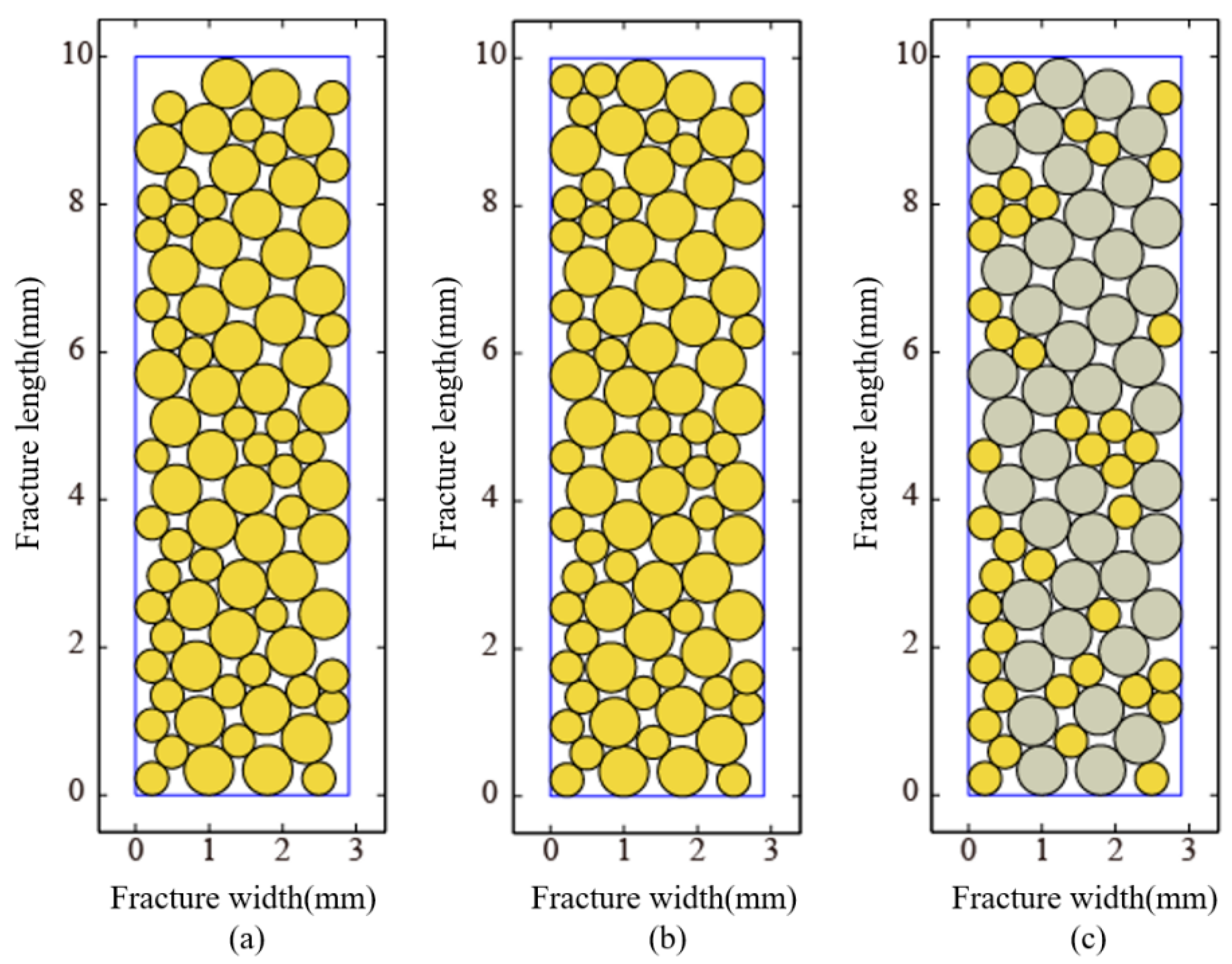
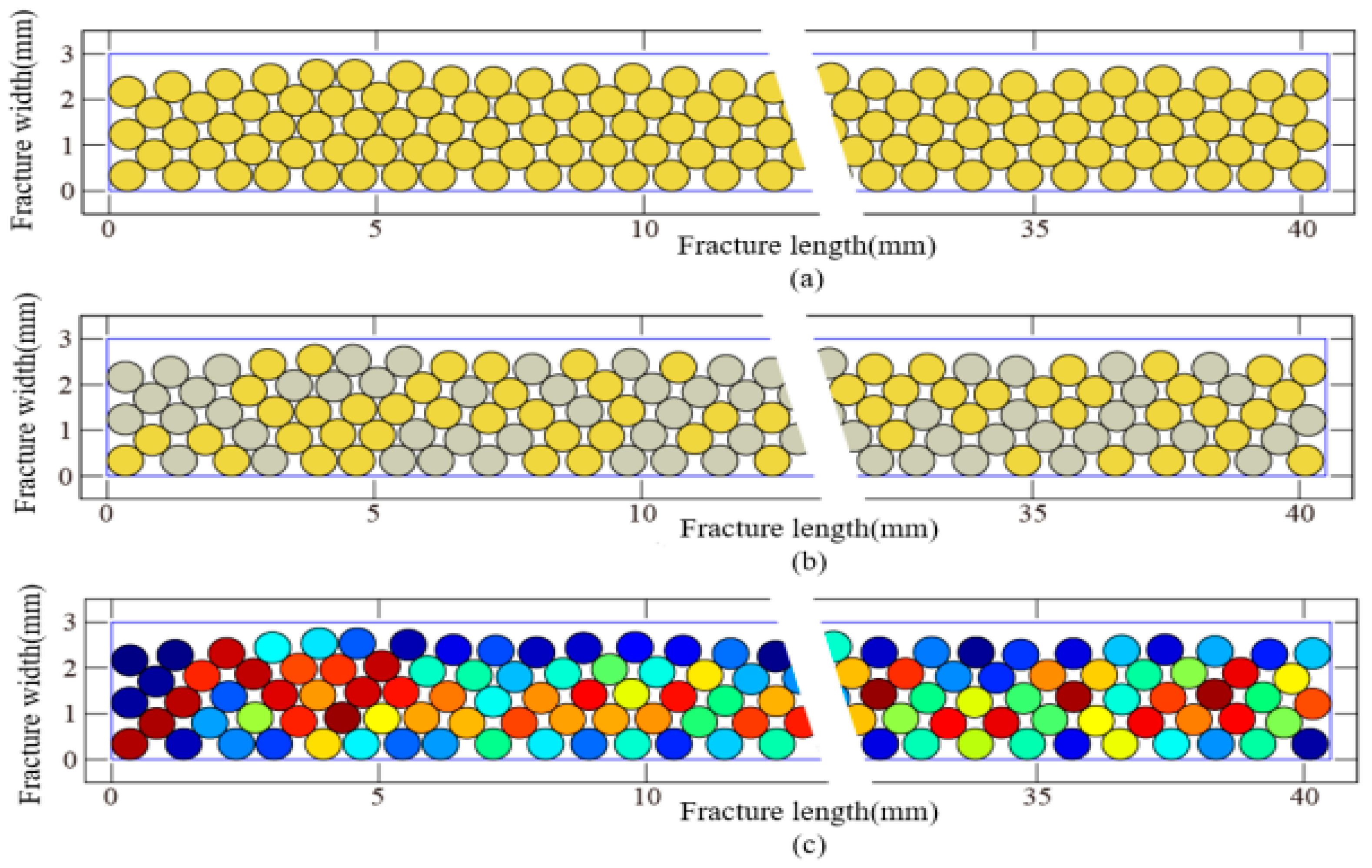
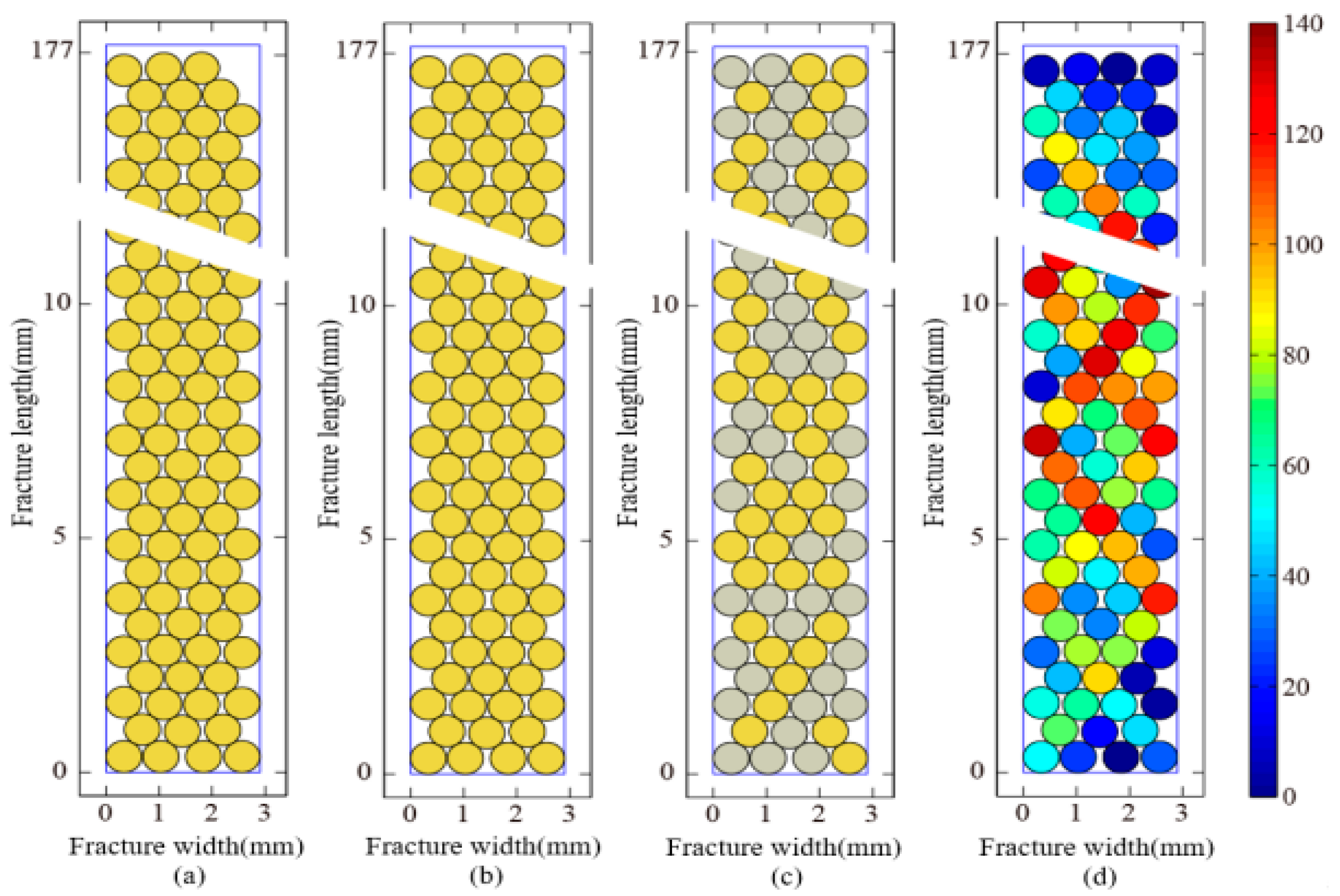
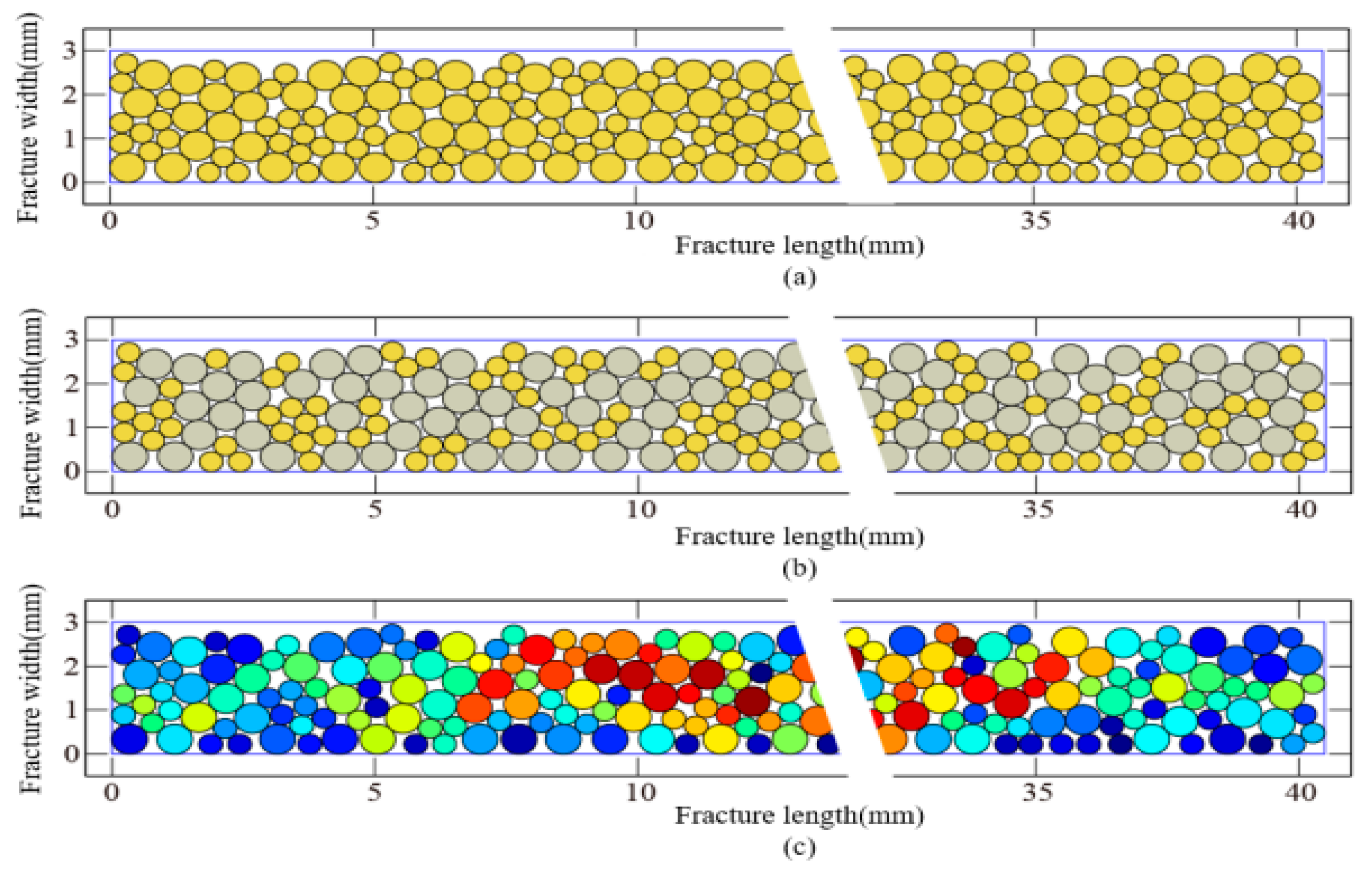
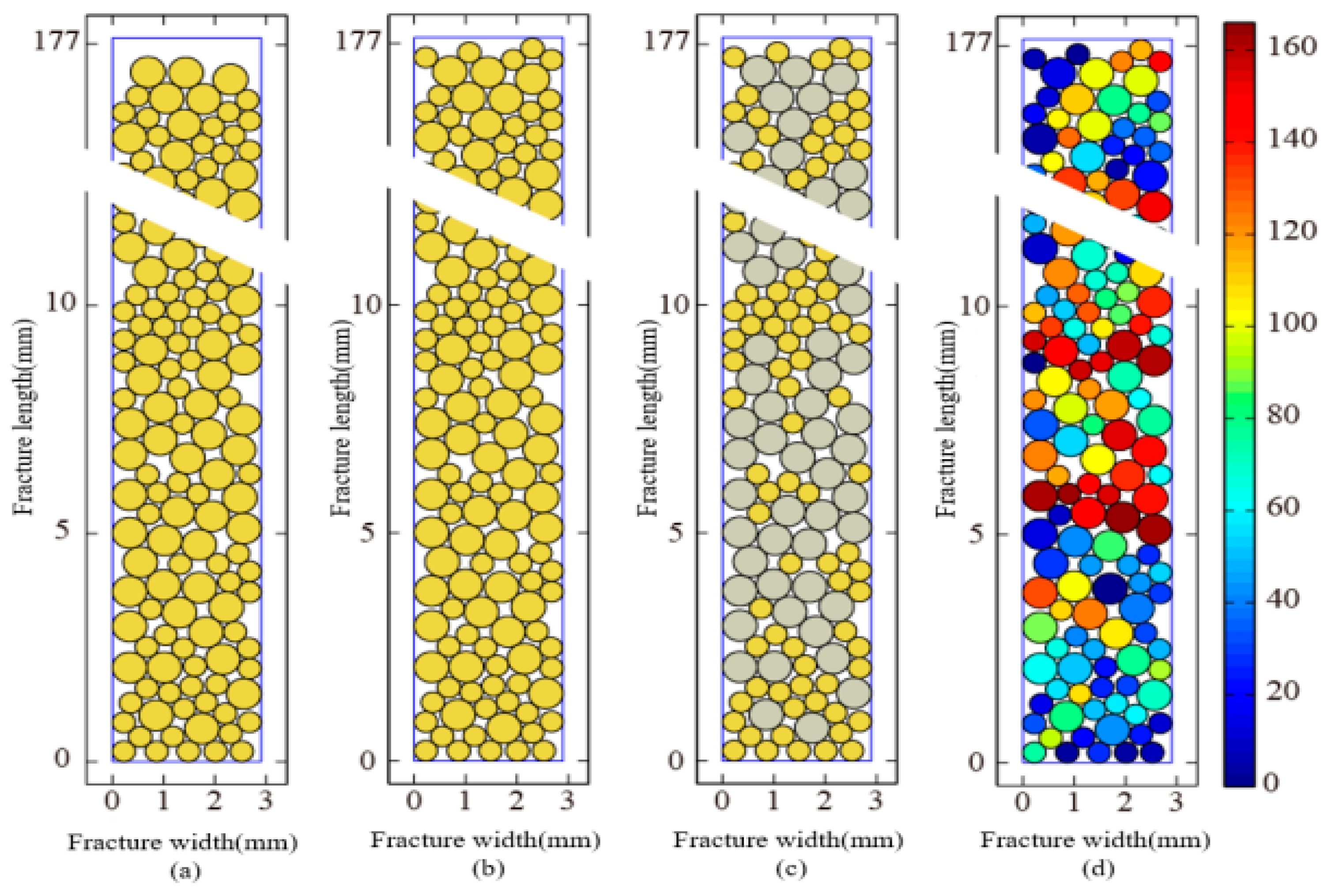

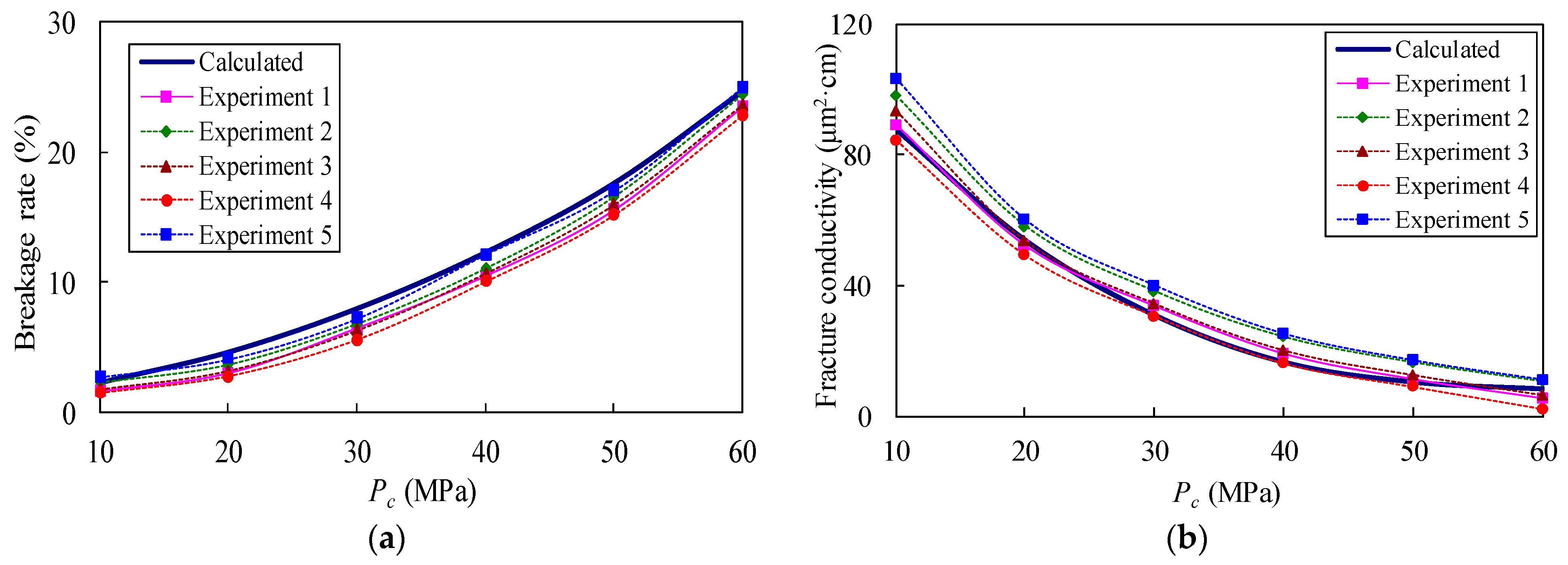

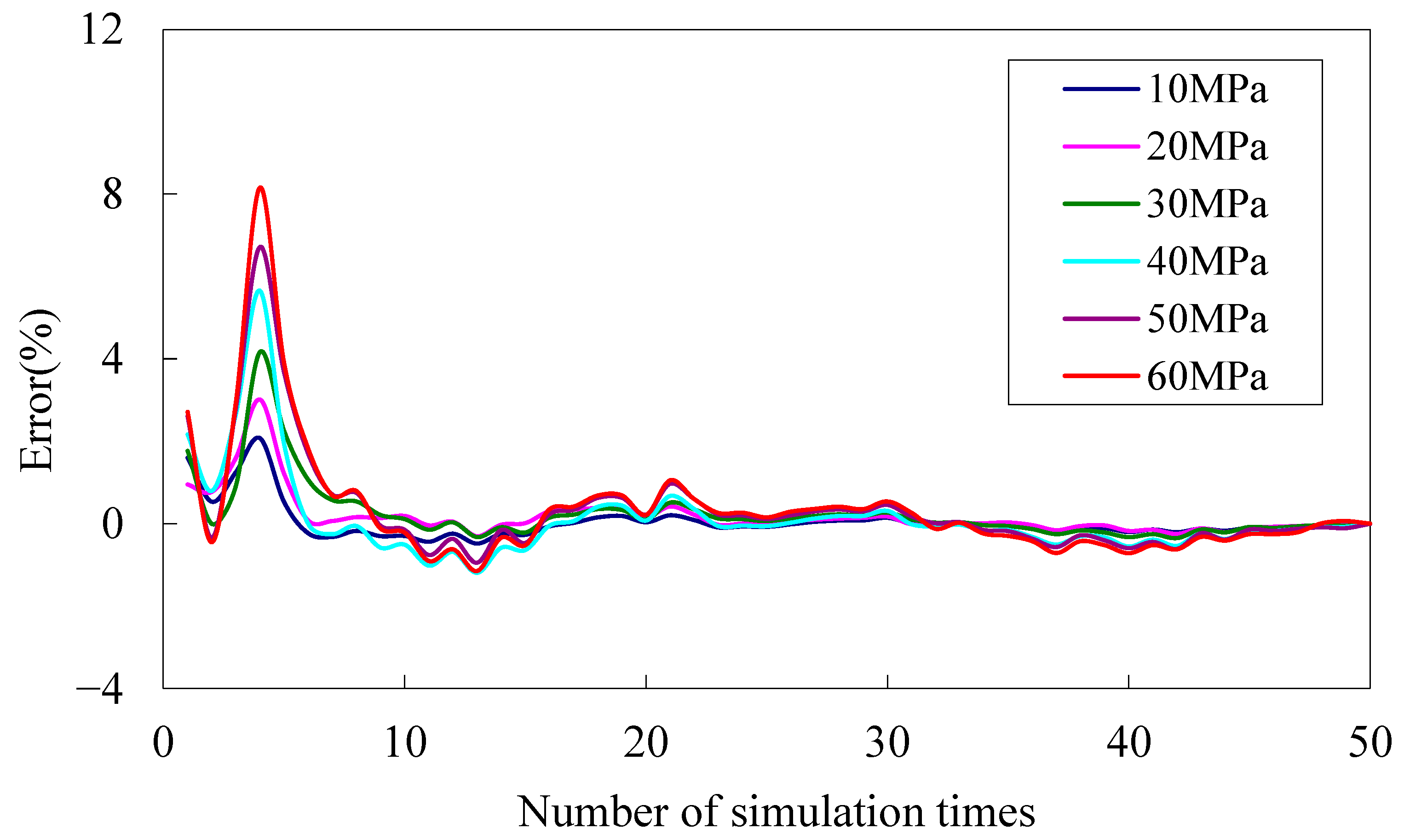
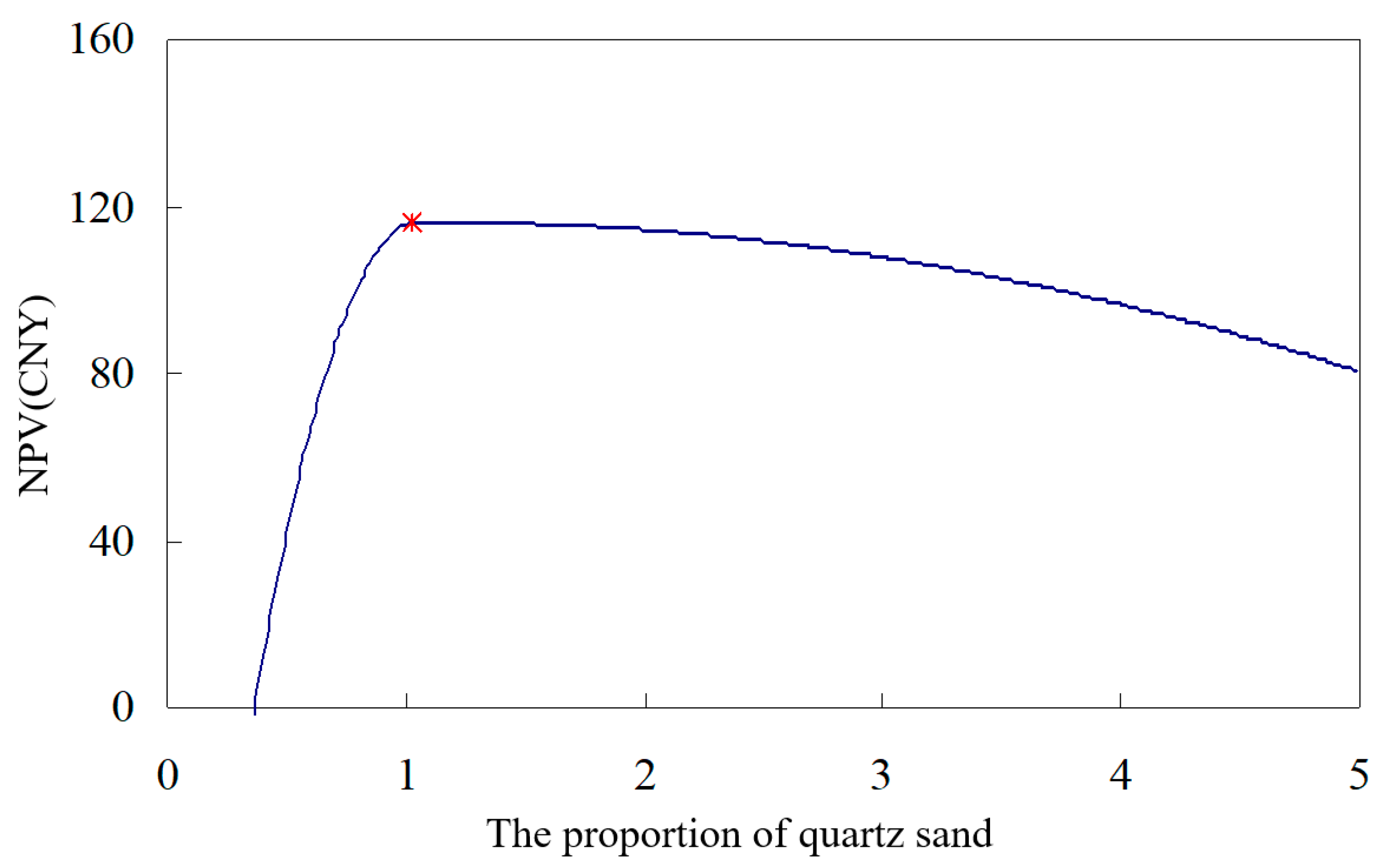

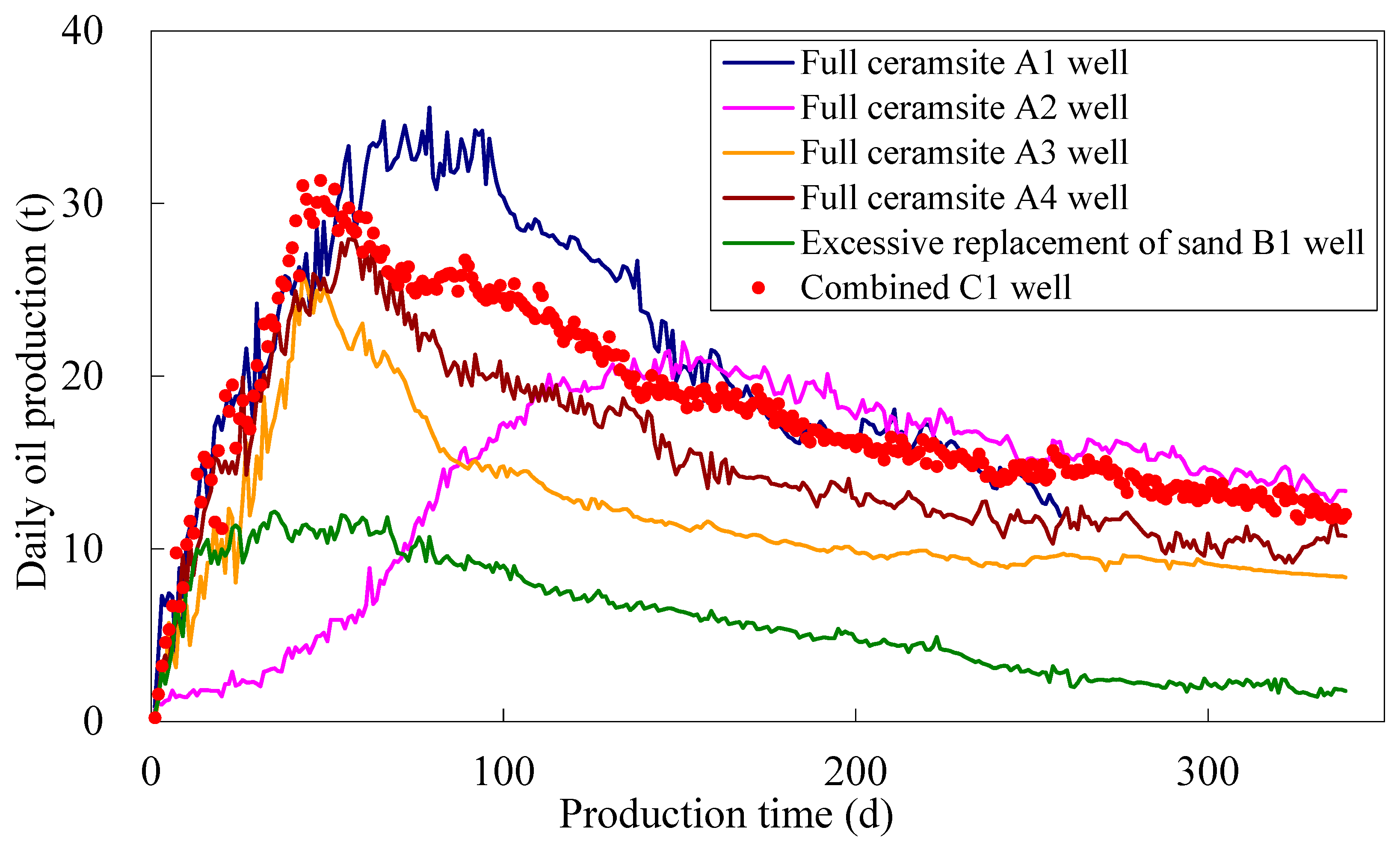
| Well | Proppant | Average Proppant Volume (m3) | Average Proppant Cost (USD) | Average Daily Production (t/d) | Cost Reduction (%) | Production Increment (%) |
|---|---|---|---|---|---|---|
| A | All ceramsite | 73.62 | 38,996 | 15.47 | / | / |
| B | Excessive all-quartz sand | 149.88 | 25,373 | 5.61 | 34.95 | −63.72 |
| C | Combined proppant | 66.67 | 25,296 | 17.66 | 40.25 | 14.10 |
Disclaimer/Publisher’s Note: The statements, opinions and data contained in all publications are solely those of the individual author(s) and contributor(s) and not of MDPI and/or the editor(s). MDPI and/or the editor(s) disclaim responsibility for any injury to people or property resulting from any ideas, methods, instructions or products referred to in the content. |
© 2024 by the authors. Licensee MDPI, Basel, Switzerland. This article is an open access article distributed under the terms and conditions of the Creative Commons Attribution (CC BY) license (https://creativecommons.org/licenses/by/4.0/).
Share and Cite
Guo, Z.; Chen, D.; Chen, Y. Numerical Calculation and Application for Crushing Rate and Fracture Conductivity of Combined Proppants. Energies 2024, 17, 3868. https://doi.org/10.3390/en17163868
Guo Z, Chen D, Chen Y. Numerical Calculation and Application for Crushing Rate and Fracture Conductivity of Combined Proppants. Energies. 2024; 17(16):3868. https://doi.org/10.3390/en17163868
Chicago/Turabian StyleGuo, Zixi, Dong Chen, and Yiyu Chen. 2024. "Numerical Calculation and Application for Crushing Rate and Fracture Conductivity of Combined Proppants" Energies 17, no. 16: 3868. https://doi.org/10.3390/en17163868






